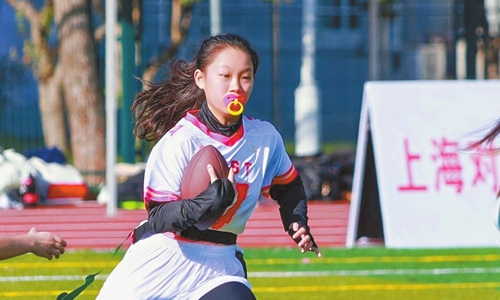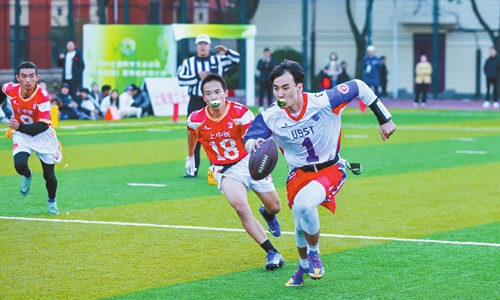
A player of a women's flag football team participates in a match at the 2024 Shanghai Student Games (University Group). Photo: Courtesy of the University of Shanghai for Science and Technology
For Beijing local Yu Bo, heading to a football pitch on a weekend has become routine. But in 2022, he shifted his choice of sport from playing association football to flag football.
"I was hoping to try some new outdoor sport during that time and flag football quickly grabbed my attention," the flag football enthusiast told the Global Times. "It is both interesting and has social attributes."
Now the manager of Beijing-based flag football club GFC, Yu said there are over 30 people who take part in flag football games every weekend.
"We have a group chat with more than 300 members, with 10 percent of them regularly participating in our weekend events," Yu said.
"When I travel to other cities like Wuhan (in Central China's Hubei Province) and Chengdu (in Southwest China's Sichuan Province), I also join the local clubs' games. Flag football enthusiasts from other cities often contact me to play when they are visiting Beijing," he added.
Olympic frontierFlag football is a non-contact version of American football where instead of tackling, players pull flags from the ball carrier's belt to stop play. It will make its Olympic debut at the 2028 Summer Games in Los Angeles, marking a significant milestone for the sport.
In China, where the sport has gained traction through grassroots initiatives and university clubs, the Olympic inclusion has catalyzed a surge of official support.
At the first national flag football working committee meeting on April 10, sports officials outlined three core goals for the next five years: securing Olympic success, establishing a standardized talent and competition system, and attracting 5 million participants.
"While flag football has thrived in Chinese communities, we face significant challenges," acknowledged Wang Yun, president of the Chinese Rugby Football Association (CRFA), during the meeting.
"Our national team is late to the game, talent pipelines are underdeveloped, and the sport has relied too much on organic growth without structured guidance."
The CRFA is now adopting a "foreign expertise" strategy, and plans to bring in international coaches and arrange training camps abroad to bridge the gap with powerhouse nations like the US and Japan.
Wan Lei, a physical education teacher at the University of Shanghai for Science and Technology (USST) and a key figure in campus flag football, believes that the sport's development is accelerating.
"I was a swimmer, but flag football's focus on teamwork and strategy fascinated me," he said. "It's a sport that teaches athletes to think quickly and communicate clearly, which are skills that transcend the field."
Wan attended the flag football working committee meeting as a university representative.
"Our 'two-track' approach, combining Olympic preparation with mass participation, plays to our strengths," he told the Global Times. "We're leveraging the national system for elite sports while building grassroots momentum."
Aybat Altay, a former captain of USST's university team and a recent addition to the national training squad, said the Olympic inclusion of the sport is a major boost.
"In terms of systematic training, tactical understanding and professional coaching, we're at the beginning," admitted Altay, noting that the Olympic opportunity offers a clear target.
"From being an enthusiast to having the opportunity to participate in the selection of the national team's training squad, I have personally experienced the development speed and potential of flag football in China."
Community growthBefore its Olympic bid, flag football grew organically in China, driven only by enthusiastic volunteers and university clubs. Despite the Olympics-related momentum, the sport faces systemic development obstacles. Chief among them is a shortage of qualified coaches and referees.
Wan noted that while foreign experts will help initially, China needs homegrown talent.
"We're starting coach training programs and integrating flag football into school curricula. The goal is to have standardized certifications so every coach knows the basics of strategy and safety," he noted.
Perception is another hurdle, as Wan said many still associate flag football with violent collisions."Flag football is non-contact, making it ideal for all ages and genders, but we need to educate people on its safety and accessibility," Wan said.
In schools, the sport's adaptability could be a strength in attracting more participants. "You don't need a large field or expensive equipment," Wan explained. "It combines elements of basketball, baseball, and athletics, making it a versatile addition to PE (physical education) classes. Students love the quick decision-making and the thrill of outsmarting opponents."
Beyond universities, community groups like the Shanghai Huddle, founded by Xiao Qiming, have played a key role in popularizing the sport.
Xiao highlights the challenge of balancing fun and competition.
"In community recruitment, people come for the social aspect, but to improve, we need structured training," Xiao told the Global Times. "Flag football's clear positional roles and strategic depth mean that even amateurs must learn teamwork and discipline."
He also underlined that sustainability is vital for the sport to grow further.
"We need to balance the excitement of the Olympics with long-term grassroots engagement. If we build strong local clubs and inclusive programs, participation numbers will follow naturally," Xiao noted, adding flag football could develop its own fan culture.
"With the increase in the number of grassroots competitions and the influx of more high-level athletes, there is also a possibility that rugby will develop a unique fan culture, attracting more people to learn about it or get involved. As this culture accumulates over time, rugby will gradually carve out its own place in China's sports culture," Xiao said.

Two men's flag football players take part in a match at the 2024 Shanghai Student Games (University Group). Photo: Courtesy of the University of Shanghai for Science and Technology





